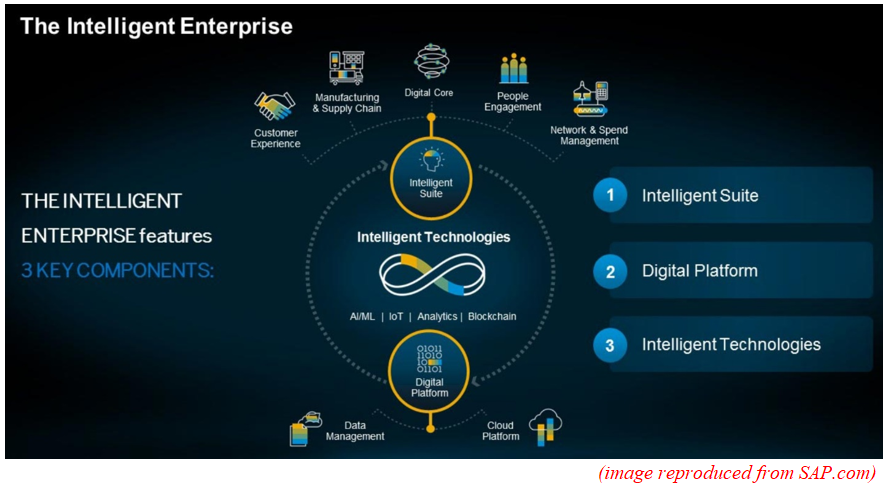Are Investments in SAP AI/ML Paying Off?
Enterprise transformation has become dynamic. Adjusting to a post-COVID-19 world provides us with an opportunity to accelerate innovative ways to usher in a new normal and challenges us to strive for moving to an “all things digital” environment. At the same time streamlining, automating and simplifying interactions for recurring tasks has become more critical than ever.
The SAP Intelligent Enterprise includes three key components, Intelligent Technologies, Digital Platform and Intelligent Suite. In this blog, we will focus on the Intelligent Technologies, Artificial Intelligence (AI)/Machine Learning (ML) and evaluate opportunities for business transformation across people, process and technology.

Technology
Artificial Intelligence is moving from a buzzword to a must-have for many organizations. As with many innovative technologies, AI has created a gold rush effect as part of business transformation. For example, robotic process automation (RPA) and the use of bots has gained greater acceptance for commoditized transaction processing, and provides a better method for achieving high volume, accuracy, and timeliness than the traditional manual methods for processing repetitive transactions. Similarly, machine learning is gaining popularity for informed and proactive decision making.
To better understand how this game-changing technology is being applied to drive business success today and where it is headed, read Protiviti’s AI survey. In this survey, Protiviti and ESI ThoughtLab interviewed more than 300 executives around the globe, reaching across functions, company size and industries including healthcare, technology, financial services, and consumer products. The clear picture gleaned from the research is this: Companies that are leading the charge with advanced AI are finding that it is a real game changer, while companies that are still lagging will soon experience a competitive disadvantage.
This brings us to understanding AI/ML in the SAP Landscape:
- SAP Leonardo is the solution we most often recommend delivering software and microservices that enable customers to leverage future-facing technologies like the Internet of Things, ML, blockchain, analytics and big data.
- Artificial Intelligence (AI) in SAP: Maricel Cabahug, SAP’s Chief Design Officer, states in her article “Designing AI for People,” “the potential of AI to transform every touchpoint between the physical and digital realms surfaces with growing regularly in the media.” Cabahug highlights the four things we can do to design AI for people:
- Design solutions
- Stay focused on our responsibilities to create solutions that benefit all
- Strive to design interactions between humans and machines in a way that caters to people’s evolutionary heritage
- Consign the right tasks to machines and keep people in charge of the work to which they are best suited.
- ML in SAP is the conquest of harnessing machine learning in its applications, uniting human expertise and computer insights. Launched on a digital platform, SAP Leonardo uses ML to provide an enterprise-grade platform for ML in the cloud.
- IoT in SAP is the next stage for ML aimed at machines that communicate using analytics, blockchain and big data. Use case applications are delivered through SAP Leonardo, which includes prepackaged use cases for 25 industries, accelerating a customer’s time to market.
We have examined some common business use cases for SAP AI/ML and share our observations here:
| AI / ML | Details |
| Natural Language Processing (NLP)
|
Using voice interface with SAP (like Amazon’s Alexa) to interact with SAP backend systems and convert simple voice commands into SAP actions. This helps businesses use voice as a user interface with SAP to post transactions, run analysis and run reports in SAP S/4HANA especially where keyboards are difficult to use, such as in plants or in the field. |
| How It Works | NLP is a collection of technologies that use algorithms and programmatic responses to simulate intelligence, with a focus on a specific task. The program simply listens for key sounds in speech and, when it detects them, follows its programming to execute certain actions |
| Machine Learning (ML)
|
Using ML in a digitized platform, the technology teaches the SAP system to perform tasks by learning from data instead of being explicitly programmed. Using ML SAP can execute:
· Automated accounts receivables processing · GR/IR matching and clearing · Automated bank reconciliation · Cash application to speed up payment matching (or flag errors, based on pattern learning) · Brand impact to analyze impact of sponsorship investments · Résumé matching to match suitable candidates to open posts · Design systems in the retail sector to identify colors that will be fashionable in summer · Devise strategies in the banking sector to avoid losing dissatisfied customers |
| How It Works | ML is designed to be cognitive, aware of context and nuance and to make decisions that are not programmatic in nature but are based on the result of a reasoned analysis. In general, it is designed to learn and adapt, to make better decisions tomorrow than the ones it made today. |
Leveraging SAP’s Leonardo platform, it is possible to address some of the most complex data model relationships that we find in business scenarios. For example, predicting customer behavior patterns for potential bad debt occurrence from analyzing past transactional data. SAP’s ML uses past transaction data for predictive analytics that are carefully managed over time so that they do not run off the rails. In addition, the ability to leverage multiple data sources using APIs for bolt-ons and other third-party data sources to pull data into SAP ML has proven to be as effective as having all that data in-house. This allows for a more agile and flexible method of leveraging ML capabilities.
People
While looking at business transformation through the people lens, given the efficiencies of AI, it is natural to worry about the effects on employment. A question that often arises is, “will AI replace me?” Consulting reports may suggest that AI equals job elimination but buried in these reports are a few key details that should calm employees. In fact, these technologies have been displacing work rather than replacing workers. AI/ML excels at replacing repetitive and commoditized aspects of knowledge work, enabling employees to spend more time on rewarding and empowering tasks. It makes space for responding to a “what if?” scenario in a proactive manner with an informed decision – powered by analysis and data. These newer technologies allow companies to encourage workers to grow in their careers, learning skills for jobs for which they may not have been previously qualified.
Competitive businesses will edge out weaker products and services in the marketplace. Using and adopting AI will enable enterprises to tailor processes to meet the changing requirements for more flexibility and allow for the fluidity of making dynamic adjustments to meet the market’s needs. Without AI, these transitions are often lengthy and require significant human intervention. Such transformation also requires a substantial amount of institutional knowledge about the business, its industry and its competitive environment. Using a collaborative tool like SAP AI/ML enables key process automation and reconfiguration activities – all of which ensure that people are still a key part of the puzzle for the long haul.
Process
Some of the SAP S/4HANA powered solutions for the office of the CFO have evolved from accounting services in record to report (RTR) to unleashing enterprise value through digital transformation. This includes using real-time data and dashboards to drive a reimagined workforce. Some of the key business processes that SAP AI/ML will impact include customer insights, sales enablement and business insights. For example, in the manufacturing sector, companies can use big data analytics to perform predictive maintenance on machines based on tools use, useful life statistics, part failure rates, etc. This allows for a reduction in unplanned downtime and a reduction in total cost of maintenance by preventing more catastrophic failures. Given the potential, we believe AI/ML will weave its way further into how operations are handled, and the way decisions and resources are managed. At its very core, business transformation is a function of increasing ease of use, enhancing user adoption and improving user experience. Enabling business transformation will compel businesses to evaluate real value for implementing AI/ML to transform business processes and must include a well-thought-out roadmap that builds on the initial investments to enable SAP AI/ML with SAP S/4HANA.
Key areas to consider when looking at AI/ML for the intelligent enterprise:
- User experience: Improve user adoption and UX for enterprise applications
- Simplification: Complete routine transactions across multiple devices using a minimal system interaction rather than lengthy data entry
- Automation: Digitize and automate the most manual processing activities
- Enablement: Train employees, regardless of the industry in which AI is deployed and its level of complexity, to successfully execute an AI-based business transformation.
Additional benefits and outcomes to becoming an Intelligent Enterprise:
- Improve analytics: Move from past period-based reporting to intelligent forecasting backed by data to build predictive dashboards and real-time analytics
- Increase automation/simplification: Build on our digital finance foundation to enable a “touchless” finance organization using enhanced AI/ML to eliminate repetitive and manual tasks
- Reorient finance talent: Increase the finance group’s value to the organization by moving to a digital workforce using AI to reorient finance talent for more analytical activities
- Enable rapid innovation: Enable the C-suite with real-time decision-making using continuous improvement for enterprise decisions.
The rise of SAP AI/ML at the digital core will raise the premium on tasks that only informed humans can do. Repetitive tasks can be increasingly automated, shining a light on skills like leadership, adaptability and creativity. As adoption continues to increase and organizations and their customers continue to benefit, it will be critical for companies to not only develop a strategy but also begin to execute and implement these tools. In fact, among early adopters, we see that more business leaders are finding that investments in SAP using AI/ML are paying off, and even pilot projects are turning in early, positive returns.
Protiviti helps our clients develop and execute their strategies in several aspects of AI/ML including:
- Identifying strategic imperatives
- Designing digital solutions
- Conducting proof-of-value projects
- Realizing scale and generating value from AI/ML.
To learn more about our SAP and Intelligent Technologies capabilities, contact us or visit Protiviti’s SAP consulting services.





